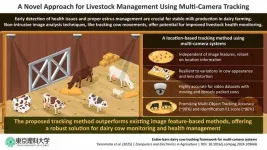(Press-News.org)
Perovskite solar cells (PSCs) present a revolutionary leap in renewable energy technology with their high efficiency, lightweight, and flexible nature. But their commercial applications are often hindered by their sensitivity to environmental factors like heat and humidity.
To address this, a team of researchers led by Professor Takashi Minemoto, a Ritsumeikan Advanced Research Academy Fellow from the College of Science and Engineering, Ritsumeikan University, Japan, along with Dr. Abdurashid Mavlonov from the Research Organization of Science and Technology, Ritsumeikan University, and Dr. Akinobu Hayakawa from Sekisui Chemical Co., Ltd., recently conducted pioneering research to investigate the durability of these PSC modules in harsh environmental conditions. This study was made available online on December 17, 2024, and was published in Volume 286 of Solar Energy on January 15, 2025.
Explaining the motivation behind this study, Prof. Minemoto says, “Perovskite solar cells stand out as particularly promising due to their low-temperature wet-coating process and compatibility with flexible substrates, offering unique opportunities for the solar industry. However, the stability of perovskite is weak compared with conventional material, which can be improved by fabrication processes such as encapsulation with barrier films.”
To analyze the durability of flexible PSC modules, the research team utilized PSC modules made of methylammonium lead iodide (MAPbI₃), which were encapsulated with polyethylene terephthalate substrate having barrier films of varying water vapor transmission rates (WVTR). The PSC modules were subjected to a damp heat test, which utilized exposure of the modules to 85 °C temperature and 85% relative humidity. The conditions were thus set to simulate real-world outdoor conditions over extended periods.
After 2,000 hours of exposure, the photovoltaic (PV) performance of the modules was recorded, and the degradation of the modules was confirmed through characteristics of current voltage, spectral reflectance, and electroluminescence.
The researchers found that high humidity led to the decomposition of the MAPbI₃ layer into lead iodide, blocking the charge transport across layers. This degradation led to a significant reduction in the efficiency of the PSC modules highlighting the detrimental impact of moisture on the PSC performance.
In addition, the findings revealed that the quality of the barrier film played a critical role in the module’s stability. Notably, the module with the lowest WVTR barrier of 5.0 × 10⁻³ g/m²/day retained 84% of its power conversion efficiency. However, the modules with higher WVTR experienced rapid degradation, ceasing to function after just 1,000 hours.
“Our study is the first to report the durability of encapsulated flexible MAPbI3-based PSC modules. When considering solar energy applications for walls and rooftops with weight limits or for mobile platforms, flexible PSCs are a great alternative to the traditional silicon panels. Insights from our study could help industries optimize these modules for highly stable and durable constructs,” explains Prof. Minemoto.
This study highlights the importance of barrier films in maintaining the long-term durability of flexible PSC modules, revolutionizing the PV industry. Additionally, by offering energy generation at multiple locations, these innovations can help reduce strain on power grids. Furthermore, improving the durability of PSC modules could also expand the use of renewable energy since it would allow the deployment of PSC modules in diverse environments, thus accelerating the global shift towards cleaner energy and a sustainable future.
***
Reference
Title of original paper: Perovskite solar cell modules: Understanding the device degradation via damp heat testing
Journal: Solar Energy
DOI: https://doi.org/10.1016/j.solener.2024.113174
About Ritsumeikan University, Japan
Ritsumeikan University is one of the most prestigious private universities in Japan. Its main campus is in Kyoto, where inspiring settings await researchers. With an unwavering objective to generate social symbiotic values and emergent talents, it aims to emerge as a next-generation research university. It will enhance researcher potential by providing support best suited to the needs of young and leading researchers, according to their career stage. Ritsumeikan University also endeavors to build a global research network as a “knowledge node” and disseminate achievements internationally, thereby contributing to the resolution of social/humanistic issues through interdisciplinary research and social implementation.
Website: http://en.ritsumei.ac.jp/
Ritsumeikan University Research Report: https://www.ritsumei.ac.jp/research/radiant/eng/
About Professor Takashi Minemoto from Ritsumeikan University, Japan
Dr. Takashi Minemoto is a Professor at the College of Science and Engineering, Ritsumeikan University, Japan, and a Ritsumeikan Advanced Research Academy Fellow. He received his Ph.D. from Ritsumeikan University in 2001. His research group deals with the development of next-generation, high-performance solar cells. With over 25 years of experience, Prof. Minemoto has authored 271 publications, contributing significantly to the development and improvement of solar technologies.
Funding information
This work is partly supported by NEDO (the New Energy and Industrial Technology Development Organization) in Japan.
END
As dairy farmers dwindle every year, the demand for high-quality milk remains steadfast, driving a surge in dairy farming. Although this shift improves efficiency, it makes managing the health of individual cows more challenging. Effective health management has thereby become a critical issue in the dairy industry. Early detection of abnormalities, swift diagnosis, prevention of disease spread, and maintaining proper breeding cycles are essential for desirable and stable milk production.
While there are invasive methods, like using mechanical devices attached to dairy cows for health ...
Researchers from the HUN-REN Biological Research Centre, Szeged (Hungary), have made a concerning discovery about the future of antibiotics. Two recent studies, published just days apart in Nature Microbiology and Science Translational Medicine found that resistance can develop against new antibiotics even before they are widely used, compromising their effectiveness from the start. The studies focused on five critical bacterial species that cause major hospital infections and examined 18 new antibiotics, some already on the market and ...
PULLMAN, Wash. — A new variety of Kentucky bluegrass has been commercially released by researchers at Washington State University.
“Matchless,” developed from another bluegrass variety called “Kenblue,” offers seed growers higher yields without the harmful impacts of burning. It also provides consumers with the option of a more environmentally friendly grass.
For several decades in the 1900s, Kentucky bluegrass growers burned fields to remove stubble after harvest, reduce thatch buildup, prevent disease, and for a number ...
Research Highlights:
Propranolol, a beta blocker medication used for treating high blood pressure and preventing migraines, may lower ischemic stroke risk in women who experience migraines frequently.
In the large analysis of more than 3 million medical records, the protective effect of propranolol was stronger for ischemic stroke compared to other stroke types and in women with migraine without aura. However, it did not have the same effect on men.
Note: The study featured in this news release is a research abstract. Abstracts presented at the American Heart Association’s scientific ...
Research Highlights:
Children who have had a stroke may be at higher risk for developing anxiety, depression and related physical symptoms such as headaches and stomach aches than their peers.
Among the study participants, the most common age for emotional challenges in young stroke survivors was around age 9.
Note: The study featured in this news release is a research abstract. Abstracts presented at the American Heart Association’s scientific meetings are not peer-reviewed, and the findings are considered preliminary until published as full manuscripts in a peer-reviewed scientific ...
Research Highlights:
Closely following a Mediterranean-style diet — rich in fruits, vegetables, beans, olive oil and some fish and chicken — was associated with improved brain health in a study of Hispanic/Latino adults in the U.S.
The Mediterranean diet provided benefits that extended beyond heart health, researchers said.
Note: The study featured in this news release is a research abstract. Abstracts presented at the American Heart Association’s scientific meetings are not peer-reviewed, and the findings are considered preliminary until published ...
Research Highlights:
People with brain bleeds had nearly 7 times higher blood levels of a specific brain protein, called glial fibrillary acidic protein (GFAP), than those who had strokes caused by clots in a study conducted in Germany.
A blood test that detects the GFAP brain protein may help doctors determine the stroke type faster and allow them to start safe treatment for people before they get to the hospital. This could reduce brain damage and lead to better outcomes for stroke patients.
Note: The study featured in this news release is a research abstract. Abstracts presented at the American Heart Association’s scientific meetings ...
Research Highlights:
By integrating 30 minutes a day of progressive walking exercise into standard stroke rehabilitation (30 to 60 minutes of physical therapy five days a week) stroke patients had a measurable improved quality of life and mobility at hospital discharge compared to a control group.
In the study, all therapists in 12 units successfully implemented the new protocol in a real-world setting with their patients as part of an improved standard of care. Each unit was responsible for onboarding new therapists and maintaining the protocol.
Note: The study featured in this news release is a research abstract. Abstracts presented ...
Research Highlights:
An artificial intelligence (AI) model designed to predict a person’s biological age (age of body cells and tissues) based on electrocardiogram (ECG) data found a strong association between ECG-age and cognitive performance.
In an analysis of more than 63,000 people in the United Kingdom, those with accelerated ECG aging had lower cognitive test scores than those with normal aging.
Note: The study featured in this news release is a research abstract. Abstracts presented at the American ...
Research Highlights:
Both F.A.S.T. and BE-FAST acronyms motivated people to call 911 right away for a possible stroke, and this impact lasted for 30 days.
F.A.S.T. outperformed BE-FAST in the ability for people to remember key stroke warning signs (face, arm and speech), suggesting the additional letters of B and E hinder memory recall.
Note: The study featured in this news release is a research abstract. Abstracts presented at the American Heart Association’s scientific meetings are not peer-reviewed, and the findings ...





